Chorus practices outdoors this year at Countryside High School in Pinellas County, Florida.
Photo courtesy of Christy King
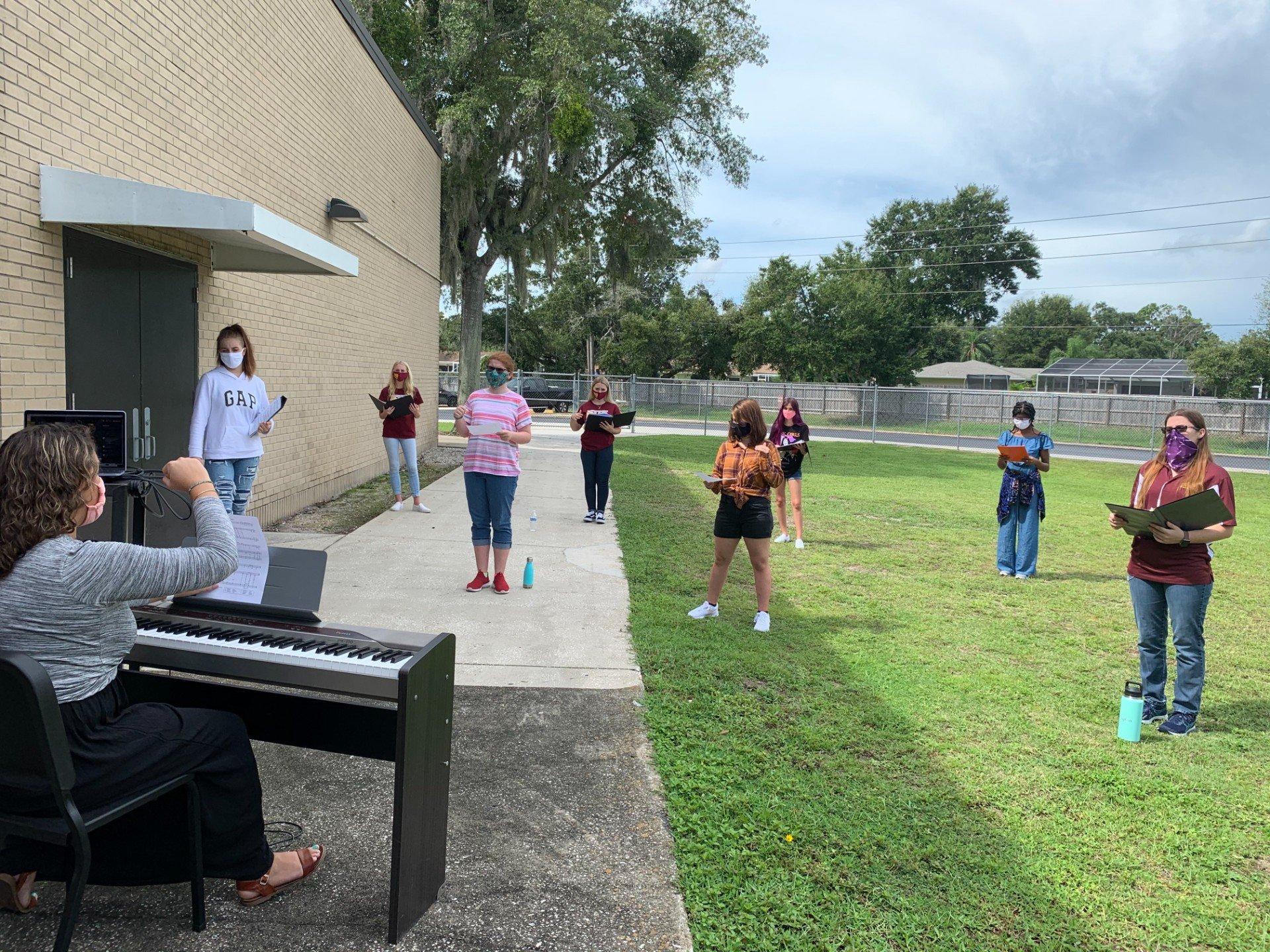
news
Puppy Pads And Slit Masks: How COVID Changed The Look Of Music Education
COVID-era problems put pressure on teachers to work creatively, while fearing for the future
Those living in Kingsman, Arizona, shouldn’t be surprised if they hear 30 kids yelling simultaneously from Lee Williams High School. That’s just Shannon Bascombe’s marching band letting out their COVID-19 frustrations.
"The kids were like, ‘Hey, Ms. B, can we, like, scream into the void for 10 seconds at the beginning of practice?'" Bascombe recalled. "'Yeah, sure, I’ll give you guys 10 seconds to just yell it out.' … Then they’ll start learning drill."
The coronavirus pandemic has made returning to school this fall a touchy debate. With each district whipping up its own tentative plan, students are either attending school armed with masks, learning virtually from home or doing a half-and-half schedule. They’ve pushed start dates, altered schedules and introduced new technology. Several schools GRAMMY.com contacted for this story set a date in September or October to reassess and adjust, aiming for in-person instruction by 2021. Needless to say, a little scream therapy is warranted—not just for students, but for teachers, parents and administrators as well.
So how does music education fit into the new school plans? Unlike math or history, which can rely on individual study, collaborative ensembles like band, chorus and orchestra cannot. With social distancing measures in place, getting a band of 50 students placed six feet apart in one room is, well, impossible. Not to mention the whole aerosol concern with kids blowing on their horns. Online group rehearsal doesn’t work either, due to latency issues.
With those difficulties in mind, districts across the country have already cut arts programs. And those teachers who still have their jobs are feeling the pressure to keep them by proving their worth.
"[Parents are] OK with the core teachers being at home and being able to give assignments," says Jake Olimpi, marching band and orchestra director at Marple Newtown High School in Pennsylvania. "But what is the art teacher doing, what is the music teacher doing? They’re getting paid and where’s the result?"
That pressure, atop the duty to keep students safe, healthy and engaged has become the new challenge for teachers, who are also haunted by the pandemic’s long lasting effects on music education.
Masks On Instruments And Puppy Pads
The spread of aerosols, a.k.a. air and saliva, forced the Centers for Disease Control to recommend the six-feet social distancing rule months ago. But when it came to the performing arts, there was little scientific evidence on how singing and instrument playing contributed to aerosol spread. A study from the National Federation of State High School Associations (NFHS), published without peer review in July, gave music teachers some answers.
Conducted by the University of Colorado Boulder, the study found that instruments released fewer aerosols if they were masked at the bell. They found even fewer aerosols when the player wore a slitted mask. In order to return to in-person ensembles, authors of the study also suggested these points:
- Musicians must stay six feet apart (nine feet for trombonists)
- Bell covers should have a Minimum Efficiency Reporting Value (MERV) of 13 (although any covering is better than none)
- Spit valves should empty into absorbent sheets like puppy pads
- Rehearsal times should be limited to 30 minutes
- Instructors should wait one HVAC air change between classes
- HEPA filters should be in rehearsal spaces
- Outdoor rehearsals are recommended over indoor ones
With the scientific guidance, teachers got to work crafting what fall 2020 would look like… and now that school’s back in session, music classes certainly don’t look like they did before. At Bascombe’s school in Arizona, they’re following the NFHS guidelines nearly to a T.
The students at Tarpon Springs Leadership Conservatory for the Arts stick to their cones and try out their new bell covers.
Credit: Anna Ottens
"When they come into the room, they have to wash their hands, drop their stuff off," Bascombe says. "We go through the symptom checker from the Mayo Clinic every day when they walk into the room… All of the doors are propped open so the kids have minimal touch. There's hand sanitizer everywhere. Mouthpiece cleaner everywhere."
Bascombe's woodwinds, brass, percussion and colorguard all get their own room. Every Friday, she spends an additional hour and a half disinfecting each room, including the bathroom her students use.
At the Southern Nevada Homeschool Performing Arts, program director Bonnie Buhler-Tanouye says brass players wear slitted masks, akin to "boys' underwear," and flute players wear shields. She says parents are willing to do even more in order to get their nearly shutdown Las Vegas music scene rolling again.
The students at Southern Nevada Homeschool Performing Arts wear face shields and slitted masks on the first day of band practice.
Courtesy: Bonnie Buhler-Tanouye
"One of the parents I was talking to the other day, because I was reminding her of masks for her trumpet player, she said, ‘You know what, put me in a hazmat suit, if you have to. Whatever we have to do to get back to playing music together,'" Buhler-Tanouye recalled.
The NFHS study deemed outdoor rehearsal better for dispersing aerosols. Summer band camps served as positive test runs for the rest of the school year, with students respectively keeping their distance. Water and sunscreen breaks are frequent and essential. In Pinellas County Schools in Florida, humidity plagues practices, but kids are happy to endure sweating for a chance to play together, says Jeanne Reynolds, performing arts specialist for the district.
"If you teach in Florida and you're a band teacher, you become a meteorologist," Jeanne said. "'Cause it’s not just hurricanes; we’ve got pretty good thunderstorms, so you have to know when to get out of harm’s way. Which we all do."
What happens when the temperature drops? When playing outside is no longer an option, bands will be forced to limit the size of their ensembles, based on dimensions of their rooms and state guidelines. Some schools have already taken band class off the schedule completely, exchanging it for smaller groups, broken up alphabetically or by instrument.
Smaller ensembles introduce two problems, though. First, smaller groups equate to more classes, meaning teachers' course loads have increased. Music programs like the one at Bergenfield High School in New Jersey rely on a large staff, which allows them to assign one teacher each to virtual and in-person classes for all of their ensembles. Bergenfield’s band director, Brian Timmons, considers his program lucky; not all schools have the resources.
Second, teachers must find music for a ragtag chamber ensemble. For example, if groups were split numerically by students' names, a director might end up with a flute, three trombones, five bass clarinets and a french horn in a class, and music for a combo like that is rare. Thankfully, publishers like Alfred, Hal Leonard and RWS Music Company have flexible arrangements that can be split into a few basic parts, and have become more available during COVID.
The supply of cleaning materials Shannon Bascombe uses to disinfect the band rooms at Lee Williams High School.
Courtesy: Shannon Bascombe
But will the music ever get performed? State guidelines vary, but indoor maximum capacity has been limited to as few as 25 people per room. Gathering an audience would be infeasible.
Perhaps concerts aren’t even necessary. According to Timmons, it’s time to shake up the dusty format anyway.
"Music education has been so performance-driven all the time," Timmons says. "And we never take time to explore the other things like the chamber playing or the composition or just ear training in and of itself or theory."
Students taking virtual band obviously don’t have to deal with these new precautions and guidelines, but they also don’t get to play together. As Timmons says, they’re working on individual assignments, like learning music production, which allows them to sew together an ensemble, piece by piece. Timmons' students will work on a shared online workspace to record music. It gives students the power to collaborate remotely, he says.
"They can listen to each other’s part and say, ‘OK, our articulation is not punching there. We’re going to have to rerecord this section,'" Timmons says. "I have three teenagers of my own. I watch them killing it on TikTok. If you can do that, there’s no reason why I can’t teach you how to do this."
And then there’s the fact that some schools are taking little to no precaution. Music teacher Nathan Smith says he was fired from Oakdale Academy in Michigan after expressing his concern over the safety of students and staff. The private Christian high school is not requiring masks this fall, per a letter sent home to parents.
"I had so many plans for this school year," Smith said. "I certainly wasn't ready to leave without seeing any of my kids again."
The Lost Generation And Long-Term Effects
It’s a struggle to keep current music students engaged, but it’s a completely new challenge to get more kids involved. Recruitment requires getting instruments into the hands of fourth graders and presenting the allure of a polished, performing ensemble—hurdles made higher by COVID.
Lackluster recruitment will have damaging effects on the future of music education, says Robert W. Smith, a composer, arranger and professor at Troy University, who has written hundreds of works for high school-level ensembles.
"We cannot have a lost generation of musicians, and we’re about to have it," Smith says.
If too few young musicians join band, orchestra and choir programs, the ensembles will see dwindling numbers in each subsequent year, all the way up to college groups.
"This is like aftershocks of an earthquake or second and third waves of a tsunami," Smith says.
Current music students also face the loss of competition and adjudication—third-party feedback that lends itself toward improvement. Many in-person music competitions have been canceled for the fall. On the upside, some organizations have offered virtual adjudication, where students and ensembles can send in their performances for assessment.
But the long-term effects aren’t all bad. Timmons insists that it’s only shifting focus for COVID-era students to prepare for a more viable music career—one that isn’t totally based on performance (though still valuable), but digital skills.
"If you’re going to be successful in music, you have to have a basic understanding of how digital audio works, even if you’re a classical-style player," Timmons says. "You gotta have an understanding. If we can teach them how to use a digital audio workstation, even if it’s some kind of cloud-based thing, recording themselves and then as a chamber ensemble recording their own product, we’re kind of unlocking skills."
All of this means that music educators are getting even more creative than before, out of necessity.
"Music teachers by nature are problems solvers. It’s what we do," Timmons says. "Listen, troubleshoot, feedback, adjustment, listen, troubleshoot, does that sound good? This is just another problem to solve. It’s just a little more problematic than fixing the intonation of a chord."
Marching Six Feet Apart: How High School Marching Bands Are Coping With The Pandemic
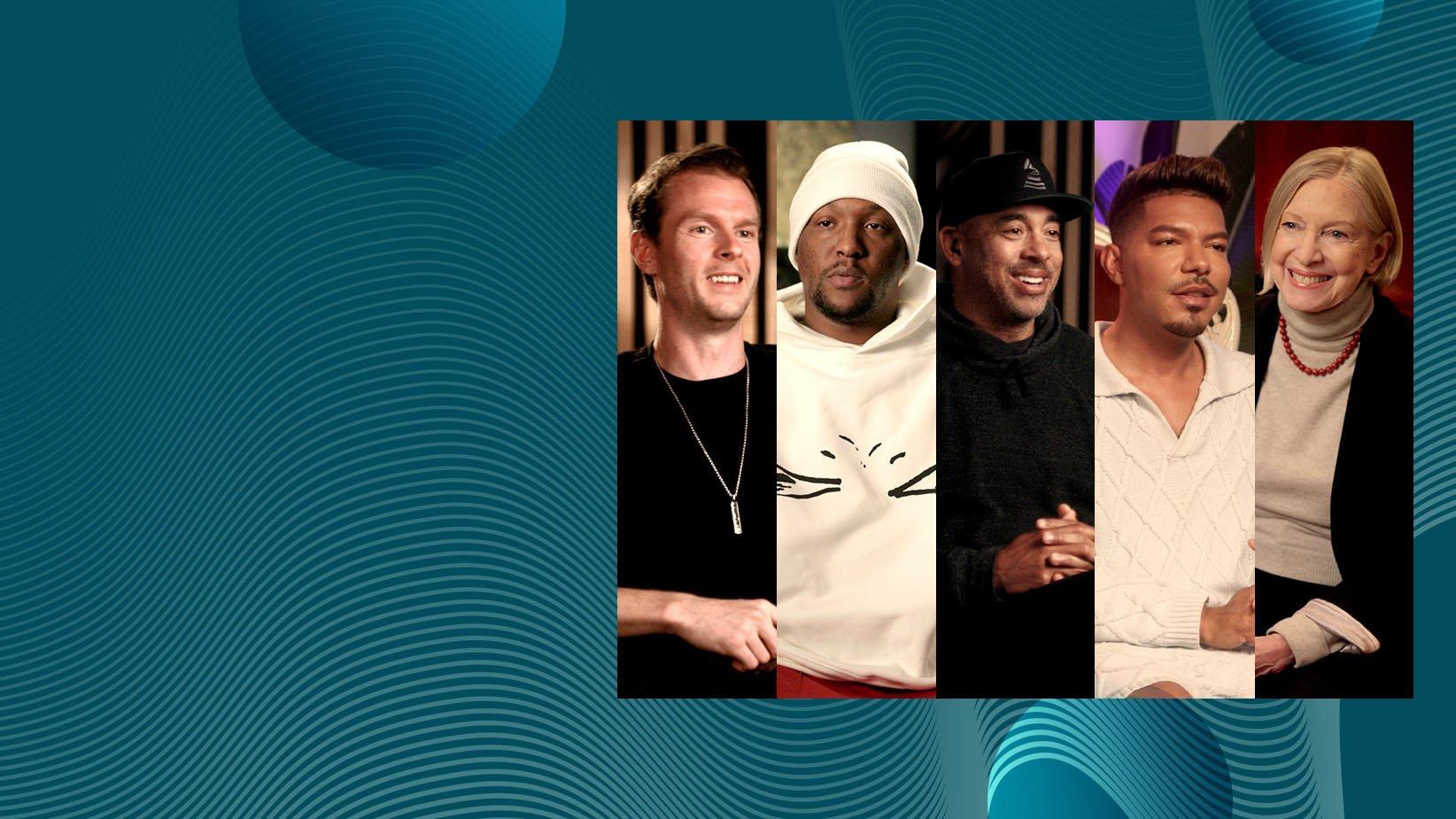
Photos Courtesy of the Recording Academy
news
The New GRAMMY GO Music Production Course Is Now Open: Featuring GRAMMY Winners Hit-Boy, CIRKUT, Judith Sherman & More
Enrollment is now open for GRAMMY GO's new specialization, "Music Production: Crafting Award-Worthy Songs," featuring appearances by GRAMMY winners and nominees. Learn music production and creative strategies from today's industry leaders.
Editor’s Note: Updated to add the Instagram Live video featuring Harvey Mason jr. and Stevie Mackey.
The Recording Academy continues its mission to empower music's next generation with the launch of its second specialization in the GRAMMY GO platform: "Music Production: Crafting Award-Worthy Songs."
This new course, a partnership between the Recording Academy and leading online learning platform Coursera, aims to bolster the technological and audio skills of music producers of all levels. The course, taught by Howard University professor and GRAMMY nominee Carolyn Malachi, features appearances by three-time GRAMMY winner and rap icon Hit-Boy, chart-topping and GRAMMY-winning producer/songwriter CIRKUT, artist and celebrity vocal coach Stevie Mackey, five-time GRAMMY nominee and Recording Academy CEO Harvey Mason jr., and 15-time GRAMMY winner Judith Sherman.
Enrollment for "Music Production: Crafting Award-Worthy Songs" is open now.
Mixing a unique blend of theory and practice, the course teaches music creators of all levels the advanced skills and tools to develop the mindset and confidence of an experienced producer and produce songs of the highest industry standards across all genres. Explore the wide-ranging roles of a music producer, develop critical listening and analysis skills, and master the technical aspects to create music and compositions that cut through the noise. The course's applied learning approach allows learners to sharpen their pre-production skills, utilize Digital Audio Workstations (DAWs) effectively, and produce vocals, instrumentals and samples collaboratively. Through critical listening exercises and discussions, learners will refine their abilities to deliver professional-quality demos.
To celebrate the launch, the Recording Academy hosted an Instagram Live session on Tuesday in which guests Harvey Mason jr. and Stevie Mackey discussed the evolving role of music producers, strategies for working with artists, key elements of top-notch productions, common mixing mistakes, tips for keeping the creative process fresh, and enrollment details for the course.
Building on the success of its first specialization, "Building Your Audience for Music Professionals," GRAMMY GO continues to offer industry-focused education tailored for emerging and established music creators and professionals alike. The innovative platform provides learners with real-time insights from leading music industry figures, ensuring the content remains practical and up to date. GRAMMY GO will also serve as an essential tool in the Recording Academy's global expansion into Africa and the Middle East, empowering music creators through enhanced training, bridging knowledge gaps, and fostering connections within the global music community.
Launched in April in partnership with Coursera, GRAMMY GO is the Recording Academy's first creator-to-creator platform, offering innovative courses tailored for both emerging and established music professionals. The initiative accelerates the Academy's global mission and reinforces its commitment to music education, providing a seamless bridge between all Academy initiatives.
Learn more about GRAMMY GO and the "Music Production: Crafting Award-Worthy Songs" and "Building Your Audience for Music Professionals" specializations.
Watch the Instagram Live session with Harvey Mason jr. and Stevie Mackey in full below:
More Music Education News & Initiatives
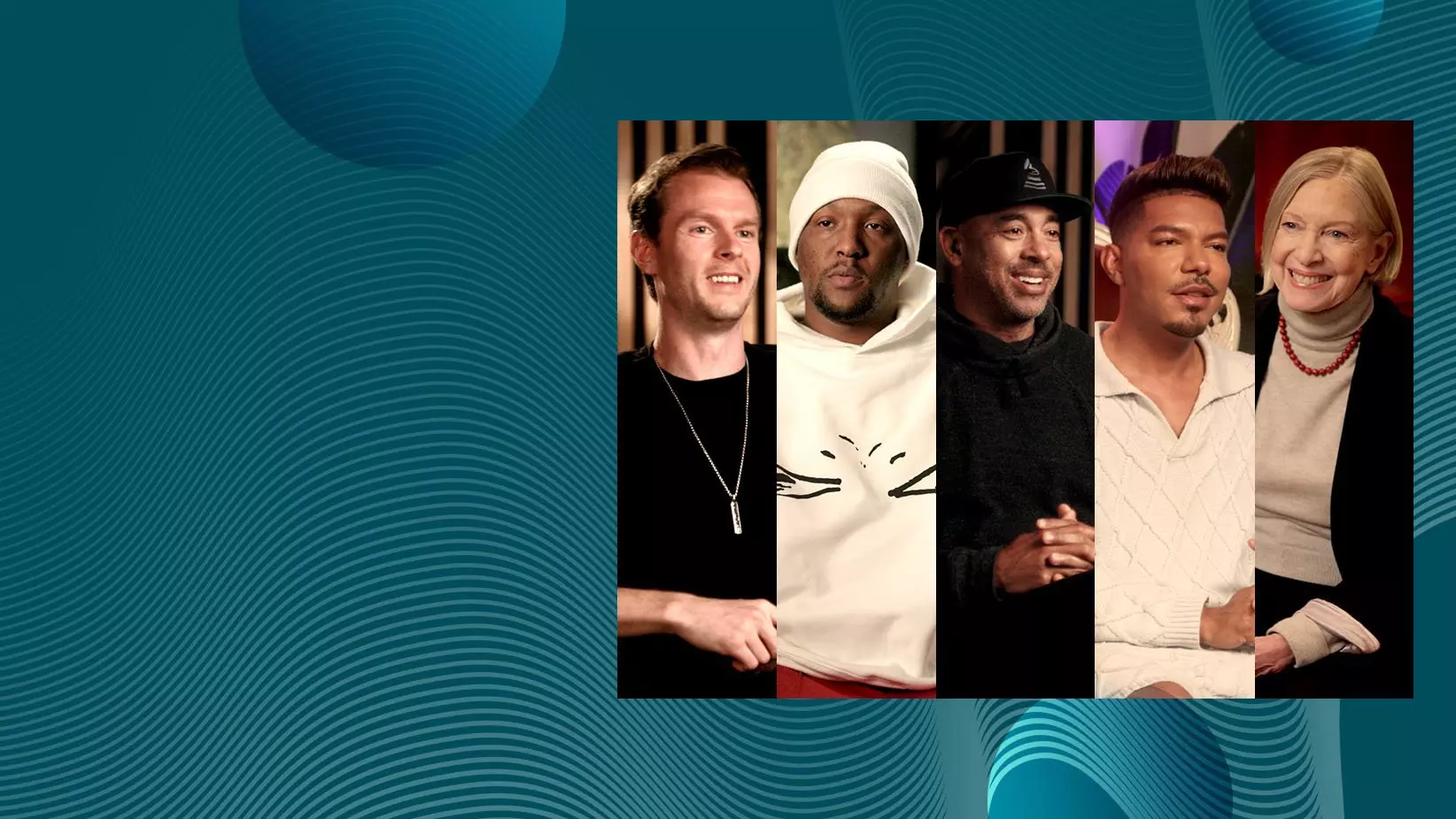
The New GRAMMY GO Music Production Course Is Now Open: Featuring GRAMMY Winners Hit-Boy, CIRKUT, Judith Sherman & More
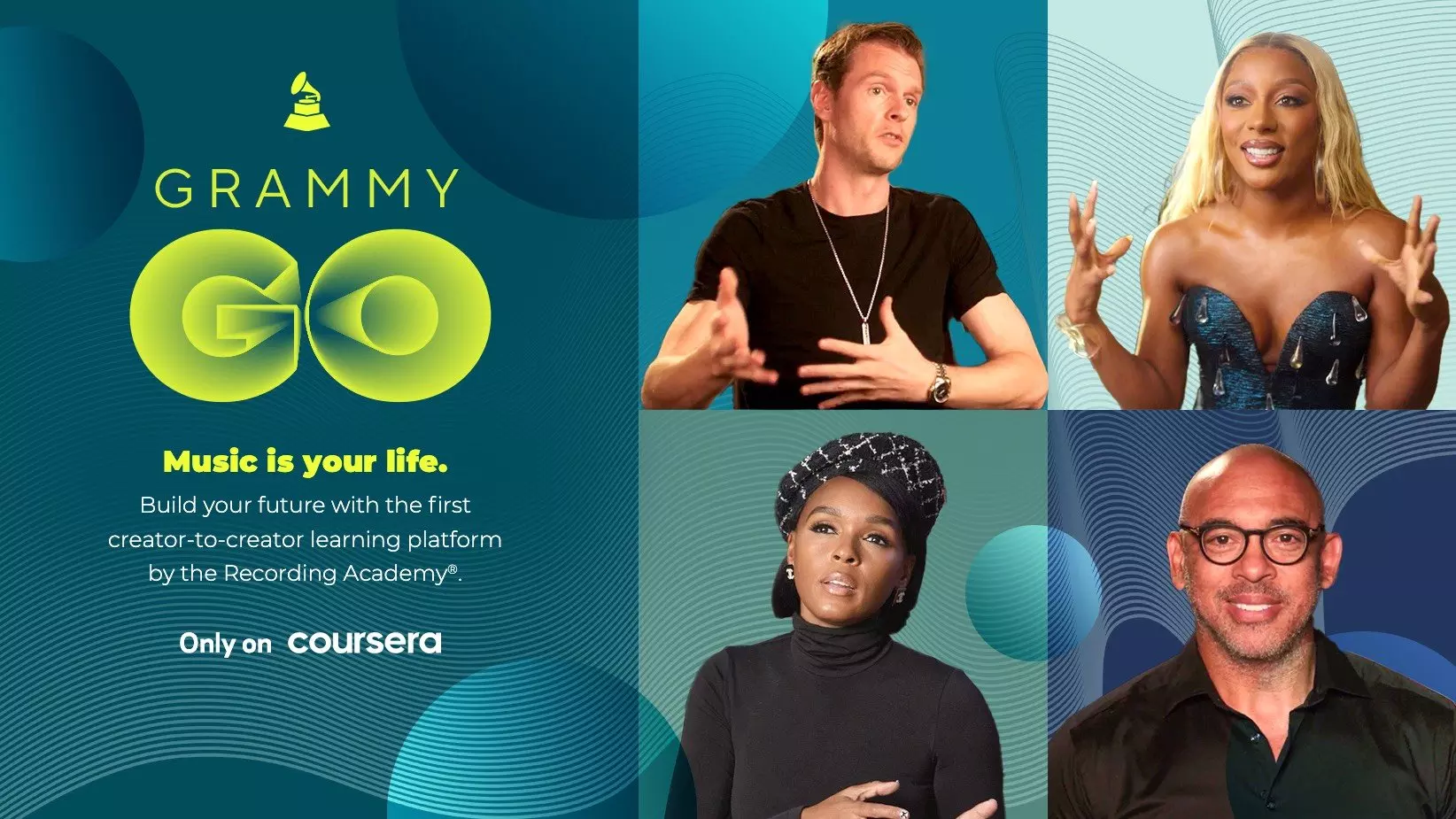
Recording Academy & Coursera Partner To Launch GRAMMY GO Online Learning Initiative

25 Semifinalists Announced For The 2024 Music Educator Award
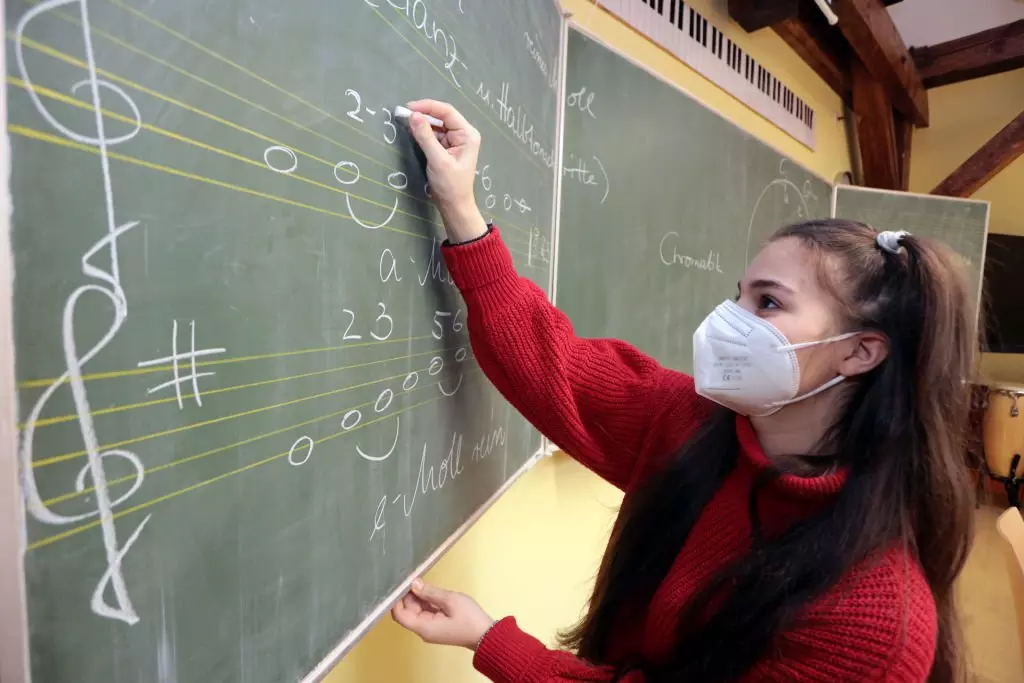
5 Music Teachers Share The Transformative Power Of Music Education
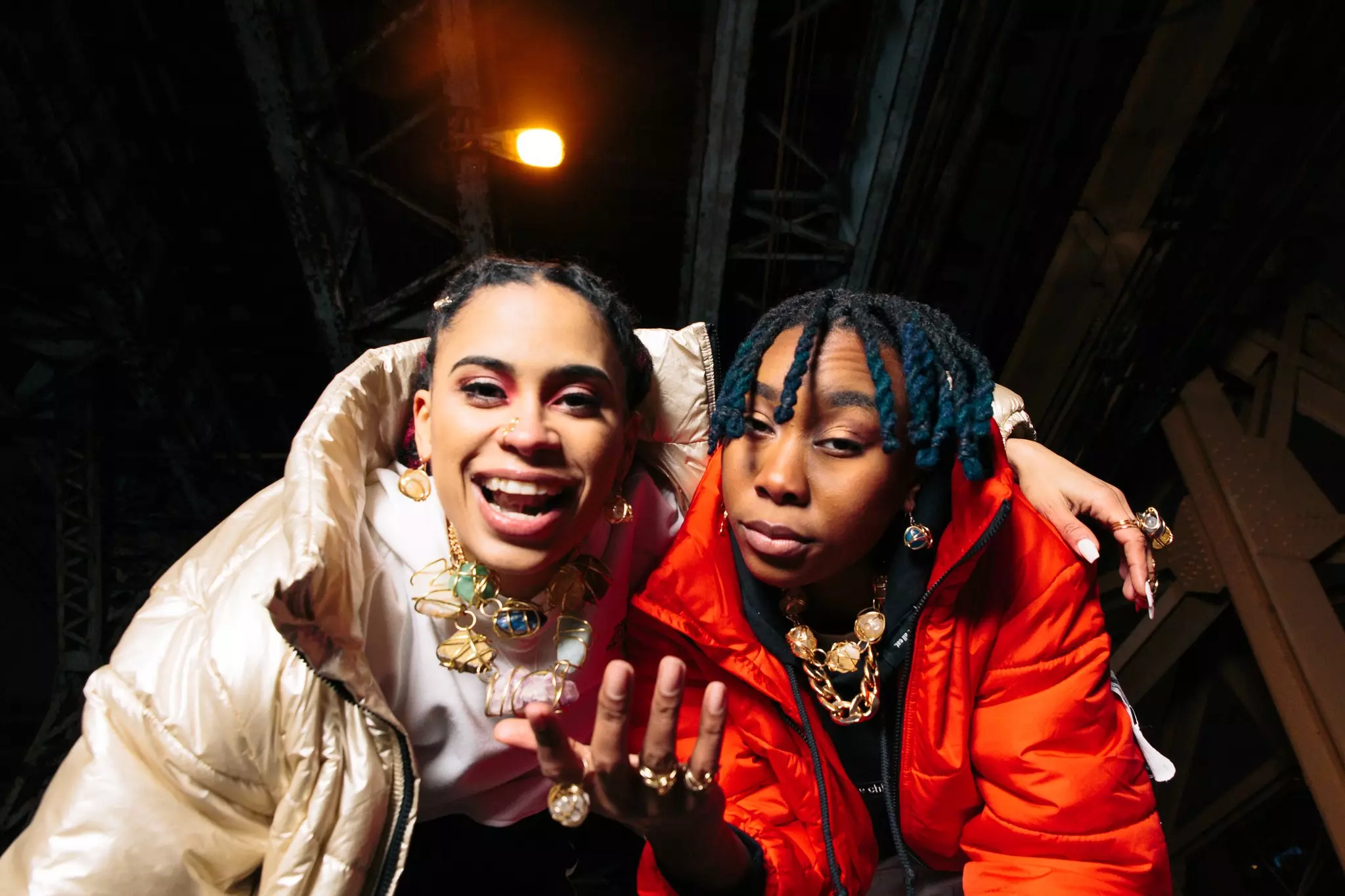
Meet Mother Nature, The Chicago Rap Duo That Teach & Live Self-Expression Through Their Miseducation Of HipHop Youth Workshops

Graphic & Photos Courtesy of GRAMMY GO
news
Recording Academy & Coursera Partner To Launch GRAMMY GO Online Learning Initiative
Class is in session. As part of the Recording Academy's ongoing mission to empower music's next generation, GRAMMY Go offers digital content in specializations geared to help music industry professionals grow at every stage of their career.
The Recording Academy has partnered with leading online learning platform Coursera on GRAMMY GO, a new online initiative to offer classes tailored for music creators and industry professionals.
This partnership empowers the next generation of the music community with practical, up-to-the moment digital content that provides wisdom for both emerging and established members of the industry. Continuing the Academy’s ongoing mission to serve all music people, courses cover a variety of specializations tailored to creative and professional growth.
GRAMMY GO on Coursera includes courses taught by Recording Academy members, featuring GRAMMY winners and nominees and offers real-life lessons learners can put to work right away.
Starting today, enrollment is open for GRAMMY GO’s first Coursera specialization, "Building Your Audience for Music Professionals," taught by Joey Harris, international music/marketing executive and CEO of Joey Harris Inc. The course features Rock & Roll Hall of Fame inductee and five-time GRAMMY winner Jimmy Jam, 10-time GRAMMY nominee Janelle Monáe and three-time GRAMMY winner and the 2024 GRAMMYs Best New Artist Victoria Monét. This foundational specialization will help participants gain the skills, knowledge and confidence to build a strong brand presence and cultivate a devoted audience within the ever-changing music industry.
The partnership’s second course, launching later this summer, aims to strengthen the technological and audio skills of a music producer. "Music Production: Crafting An Award-Worthy Song" will be taught by Carolyn Malachi, Howard University professor and GRAMMY nominee, and will include appearances by GRAMMY winner CIRKUT, three-time GRAMMY winner Hit-Boy, artist and celebrity vocal coach Stevie Mackey, five-time GRAMMY nominee and Recording Academy CEO Harvey Mason jr., and 15-time GRAMMY winner Judith Sherman. Pre-enrollment for "Music Production: Crafting An Award-Worthy Song" opens today.
"Whether it be through a GRAMMY Museum program, GRAMMY Camp or GRAMMY U, the GRAMMY organization is committed to helping music creators flourish, and the Recording Academy is proud to introduce our newest learning platform, GRAMMY GO, in partnership with Coursera," said Panos A. Panay, President of the Recording Academy. "A creator’s growth path is ongoing and these courses have been crafted to provide learners with the essential tools to grow in their professional and creative journeys."
"We are honored to welcome GRAMMY GO, our first entertainment partner, to the Coursera community," said Marni Baker Stein, Chief Content Officer at Coursera. "With these self-paced online specializations, aspiring music professionals all over the world have an incredible opportunity to learn directly from iconic artists and industry experts. Together with GRAMMY GO, we can empower tomorrow's pioneers of the music industry to explore their passion today."
GRAMMY GO also serves as the music community’s newest digital hub for career pathways and editorial content that provides industry insights for members of the industry; visit go.grammy.com for more. For information and enrollment, please visit the landing pages for "Building Your Audience for Music Professionals" and "Music Production: Crafting An Award-Worthy Song."

Photo: Jeff Kravitz/FilmMagic
video
GRAMMY Rewind: Kendrick Lamar Honors Hip-Hop's Greats While Accepting Best Rap Album GRAMMY For 'To Pimp a Butterfly' In 2016
Upon winning the GRAMMY for Best Rap Album for 'To Pimp a Butterfly,' Kendrick Lamar thanked those that helped him get to the stage, and the artists that blazed the trail for him.
Updated Friday Oct. 13, 2023 to include info about Kendrick Lamar's most recent GRAMMY wins, as of the 2023 GRAMMYs.
A GRAMMY veteran these days, Kendrick Lamar has won 17 GRAMMYs and has received 47 GRAMMY nominations overall. A sizable chunk of his trophies came from the 58th annual GRAMMY Awards in 2016, when he walked away with five — including his first-ever win in the Best Rap Album category.
This installment of GRAMMY Rewind turns back the clock to 2016, revisiting Lamar's acceptance speech upon winning Best Rap Album for To Pimp A Butterfly. Though Lamar was alone on stage, he made it clear that he wouldn't be at the top of his game without the help of a broad support system.
"First off, all glory to God, that's for sure," he said, kicking off a speech that went on to thank his parents, who he described as his "those who gave me the responsibility of knowing, of accepting the good with the bad."
Looking for more GRAMMYs news? The 2024 GRAMMY nominations are here!
He also extended his love and gratitude to his fiancée, Whitney Alford, and shouted out his Top Dawg Entertainment labelmates. Lamar specifically praised Top Dawg's CEO, Anthony Tiffith, for finding and developing raw talent that might not otherwise get the chance to pursue their musical dreams.
"We'd never forget that: Taking these kids out of the projects, out of Compton, and putting them right here on this stage, to be the best that they can be," Lamar — a Compton native himself — continued, leading into an impassioned conclusion spotlighting some of the cornerstone rap albums that came before To Pimp a Butterfly.
"Hip-hop. Ice Cube. This is for hip-hop," he said. "This is for Snoop Dogg, Doggystyle. This is for Illmatic, this is for Nas. We will live forever. Believe that."
To Pimp a Butterfly singles "Alright" and "These Walls" earned Lamar three more GRAMMYs that night, the former winning Best Rap Performance and Best Rap Song and the latter taking Best Rap/Sung Collaboration (the song features Bilal, Anna Wise and Thundercat). He also won Best Music Video for the remix of Taylor Swift's "Bad Blood."
Lamar has since won Best Rap Album two more times, taking home the golden gramophone in 2018 for his blockbuster LP DAMN., and in 2023 for his bold fifth album, Mr. Morale & the Big Steppers.
Watch Lamar's full acceptance speech above, and check back at GRAMMY.com every Friday for more GRAMMY Rewind episodes.
10 Essential Facts To Know About GRAMMY-Winning Rapper J. Cole
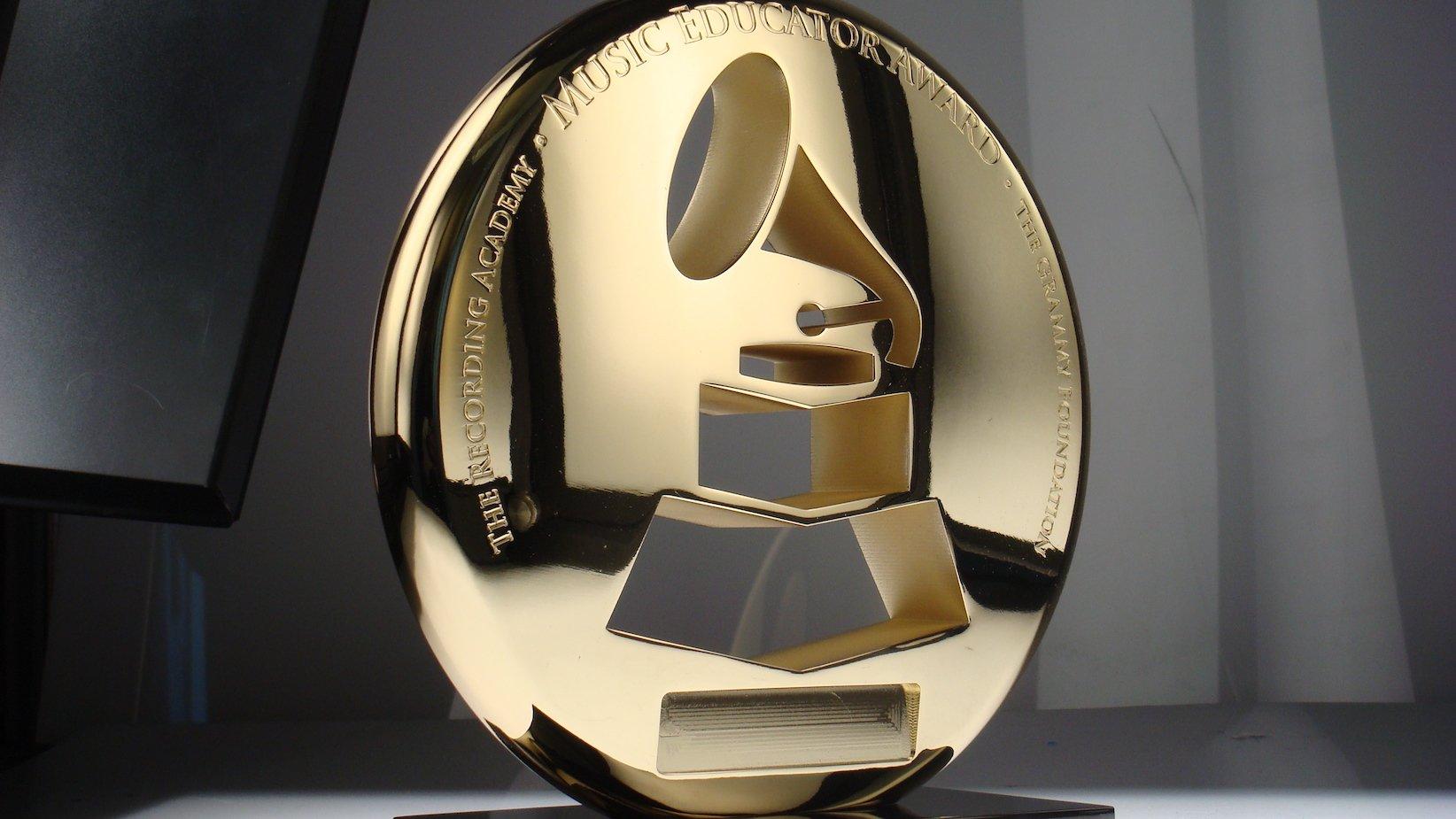
Photo Courtesy of the Recording Academy and GRAMMY Museum
news
25 Semifinalists Announced For The 2024 Music Educator Award
Twenty-five music teachers, from 25 cities across 17 states, have been announced as semifinalists for the 2024 Music Educator Award, presented by the Recording Academy and GRAMMY Museum. One ultimate recipient will be honored during GRAMMY Week 2024.
Twenty-five music teachers have today been announced as semifinalists for the Music Educator Award, an annual award, presented by the Recording Academy and GRAMMY Museum, that supports and celebrates music education and music educators across the U.S. The 25 semifinalists, who hail from 25 cities across 17 states, were selected from a pool of more than 2,000 initial nominations from across all 50 U.S. states. Finalists will be announced in December, and the ultimate recipient of the 2024 Music Educator Award will be recognized during GRAMMY Week 2024, days ahead of the 2024 GRAMMYs.
Nominations for the 2025 Music Educator Award are now open.
Presented by the Recording Academy and GRAMMY Museum, the Music Educator Award recognizes current educators who have made a significant and lasting contribution to the music education field and demonstrate a commitment to the broader cause of maintaining music education in the schools. The Award is open to current U.S. music teachers. Anyone can nominate a teacher — students, parents, friends, colleagues, community members, school deans, and administrators — while teachers are also able to nominate themselves; nominated teachers are notified and invited to fill out an application.
Each year, the recipient of the Music Educator Award, selected from 10 finalists, receives a $10,000 honorarium and matching grant for their school's music program. The nine additional finalists receive a $1,000 honorarium and matching grants. The remaining 15 semifinalists, among the group announced today, will receive a $500 honorarium with matching school grants.
The Music Educator Award program, including honorariums, is made possible by the generosity and support of the Chuck Lorre Family Foundation. In addition, the American Choral Directors Association, National Association for Music Education, NAMM Foundation, and National Education Association support this program through outreach to their constituencies.
Read More: 5 Organizations And Scholarships Supporting Music Education
The full list of the 2024 Music Educator Award semifinalists is as follows:
| Name | School | City | State |
|---|---|---|---|
| Dawn Amthor | Wallkill Senior High School | Wallkill | New York |
| Jeremy Bartunek | Greenbriar School | Northbrook | Illinois |
| William Bennett | Cane Bay High School | Summerville | South Carolina |
| Meg Byrne | Pleasant Valley High School | Bettendorf | Iowa |
| Ernesta Chicklowski | Roosevelt Elementary | Tampa | Florida |
| Michael Coelho | Ipswich Middle and High School | Ipswich | Massachusetts |
| Drew Cowell | Belleville East High School | Belleville | Illinois |
| Marci DeAmbrose | Lincoln Southwest High School | Lincoln | Nebraska |
| Antoine Dolberry | P.S. 103x Hector Fontanez | Bronx | New York |
| Jasmine Fripp | KIPP Nashville Collegiate High School | Nashville | Tennessee |
| J.D. Frizzell | Briarcrest Christian School | Eads | Tennessee |
| Amanda Hanzlik | E.O. Smith High School | Storrs | Connecticut |
| Michael Lapomardo | Shrewsbury High School | Shrewsbury | Massachusetts |
| Ashleigh McDaniel Spatz | Rising Starr Middle School | Fayetteville | Georgia |
| Kevin McDonald | Wellesley High School | Wellesley | Massachusetts |
| Coty Raven Morris | Portland State University | Portland | Oregon |
| Trevor Nicholas | Senn Arts at Nicholas Senn High School | Chicago | Illinois |
| Vicki Nichols | Grandview Elementary | Grandview | Texas |
| Annie Ray | Annandale High School | Annandale | Virginia |
| Bethany Robinson | Noblesville High School | Noblesville | Indiana |
| Danni Schmitt | Roland Park Elementary/Middle School | Baltimore | Maryland |
| Kevin Schoenbach | Oswego High School | Oswego | Illinois |
| Matthew Shephard | Meridian Early College High School | Sanford | Michigan |
| Alice Tsui | New Bridges Elementary | Brooklyn | New York |
| Tammy Yi | Chapman University | Orange | California |
Learn more about the Music Educator Award and apply to the 2025 Music Educator Award program now.
5 Music Teachers Share The Transformative Power Of Music Education
